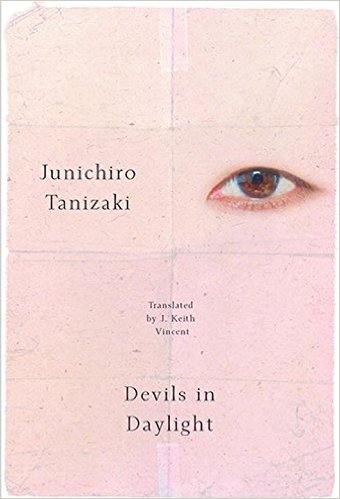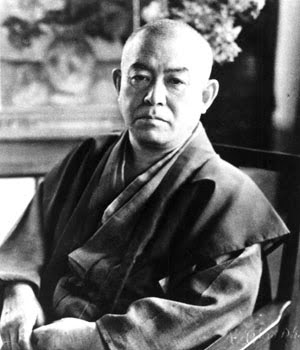“What I am about to tell you is a secret. You are not to breathe a word of it to another soul! Later tonight, at around one o’clock, in a certain part of Tokyo, a crime…a homicide will be performed. I want to get ready now and go see it happen, and I want you to go as well. So what do you say? Will you join me?”—Sonomura, who learned of this planned crime through a series of cryptograms.
 If a narrative inspired by the discovery of coded messages sounds familiar to students of American literature, it may be because so many of us read Edgar Allan Poe’s “The Gold-Bug” as students. The plot of “The Gold-Bug,” also a favorite in Japan after its translation and publication there in 1902, depends on cryptography for its mystery and excitement, and this appealed especially to author Junichiro Tanizaki (1886 – 1965), who borrowed much from Poe, including the idea of cryptography, as he developed the plot and narrative style of his own work, Devils in Daylight. Serialized simultaneously in two newspapers in Tokyo and Osaka in 1918, this short book found a ready audience in a country already well familiar with Poe, and Tanizaki added some twists of his own, making his story even more attractive to his audience – it is far more psychological, even twisted, and more obviously sexual. He creates visions of reality and fiction on three levels – that of the author as he creates and develops the basic story, that of the fictional characters as they “live” their stories, and that of the reader, who accepts as “truth” the actions created by the author and the reactions of the characters, then brings his/her own interpretations to the narrative and its implications.
If a narrative inspired by the discovery of coded messages sounds familiar to students of American literature, it may be because so many of us read Edgar Allan Poe’s “The Gold-Bug” as students. The plot of “The Gold-Bug,” also a favorite in Japan after its translation and publication there in 1902, depends on cryptography for its mystery and excitement, and this appealed especially to author Junichiro Tanizaki (1886 – 1965), who borrowed much from Poe, including the idea of cryptography, as he developed the plot and narrative style of his own work, Devils in Daylight. Serialized simultaneously in two newspapers in Tokyo and Osaka in 1918, this short book found a ready audience in a country already well familiar with Poe, and Tanizaki added some twists of his own, making his story even more attractive to his audience – it is far more psychological, even twisted, and more obviously sexual. He creates visions of reality and fiction on three levels – that of the author as he creates and develops the basic story, that of the fictional characters as they “live” their stories, and that of the reader, who accepts as “truth” the actions created by the author and the reactions of the characters, then brings his/her own interpretations to the narrative and its implications.

Junichiro Tanikzaki (1886 – 1965), is widely regarded as the greatest Japanese writer of the twentieth century. The Tanizaki Prize, established in 1965 in his honor, is Japan’s highest literary award.
Romantic, even gothic in its approach, it is a tale which entices the reader through the speed of its narrative, moving so quickly that Coleridge’s “willing suspension of disbelief” is intensified – the reader wants to get on with the excitement and does not want to be bothered much about the obviously bizarre (and unrealistic) circumstances which make the excitement possible. The atmosphere and tone of the book are set when the narrator, Takahashi, recalls a telephone call he received from his friend Sonomura, who asks him to come to his house immediately. Takahashi, a writer, has been up all night, working on a deadline, and is not able to travel to Sonomura’s right away. He is nervous about the call, informing the reader that mental illness runs in Sonomura’s family, and that he has concluded that “This time…Sonomura really had been stricken with lunacy.” Sonomura, quoted in the opening lines of this review, tells Takahashi (and the reader) that he knows, for sure, that at one o’clock that night, a murder will take place in a certain part of Tokyo. He does not know exactly where, but he wants to go see it happen. He also wants Takahashi to be there with him. Fearing for his “poor friend’s sanity” and worried that “he really has lost his mind, Takahashi agrees to go to his friend’s house when his work is finished.

The male involved in the murder plans looks like famed kibuki actor Onoe Kikugoro V, according to Sonomura.
Tanizaki’s ability to convey Sonomura’s excitement and Takahashi’s obvious concern for his friend’s sanity make these opening lines particularly attention-getting when Takahashi suddenly begins to worry that Sonomura might be planning to murder HIM. When Sonomura offers Takahashi a piece of paper containing the same kind of code that Poe used in “The Gold Bug,” he explains that he received it two days ago – or, rather, picked it up from the floor of a movie theatre after watching someone in front of him read and discard it. Eventually, after delays of several hours, Takahashi and Sonomura leave for the event. Since this is at the beginning of the story, it gives away nothing to say that they do get there in time to peer through some knot holes to observe a murder taking place, after which they must escape without making noise. They note that the murderer resembles Onoe Kikugoro V, a famed kabuki theatre actor. The woman intimately involved in the murder is gorgeous, and even Takahashi becomes excited by her sadistic behavior during the crime.
Tanizaki’s ability to tell this tale with a straight face is admirable, and even more admirable is his ability to get the reader to care enough about the action and characters to keep reading. Enough hints are dropped and enough information is withheld to keep the reader on edge from suspense while wondering where the author will go with this narrative. Much sarcasm, casual humor, and irony make their way into the scene of the murder, and as both men want to get closer to the mysterious woman involved in the murder, the sexual connotations are obvious. Takahashi is interested in learning about her motives, wondering who she really is and how many more murders she might have been involved in. Sonomura declares that “It’s only seeing things like what we saw tonight that prevents me from going insane from sheer monotony.” He sees the female murderer as a “heroine ripped from the pages of a detective novel, a fantasy he has longed for,” and hopes she will come to comfort him in his loneliness. To say more would involve giving spoilers, but the story does become more complex over the course of several weeks. The conclusion will keep book clubs busy with discussion.

When Takahashi first goes to Sonomura’s house, he is not sure he wants to be involved in his plans, so he spends some time pacing outside the gate to the nearby Zojo-ji Temple.
Devils in Daylight seems made for film, and Tanizaki may have written it with that aspect in mind. Japanese silent film had been popular since the beginning of the century, and Tanizaki himself eventually worked as a screenwriter, adding yet another level of possibility to any discussion of the novella – a writer of fiction who also writes for a visual medium may see one reality from two different perspectives. The book explores reality and fiction (or fantasy) from many different perspectives, and as the action develops well beyond what has been mentioned here, the complexities of exploring different aspects of reality at the same time that everyone in the novel is allowing his/her imagination to run free, fills the book with fascinating side issues. Even translator J. Keith Vincent, in his detailed Afterword, explains how he interprets the novella and its issues and what he did to make it more “real,” from his choice of words and phrases, some of them translated directly from Poe and inserted here, to the title of the book, which Vincent chose for its ironic connotations – “the devils in this story do not operate in daylight,” he says. Much of the reality here is connected to visual performance – from the staging of the murder, to use of night to enhance the images the reader derives from the action, the ultimate ironies being that we see these different “realities” in a work of fiction.
ALSO by Tanizaki: A CAT, A MAN and TWO WOMEN, SOME PREFER NETTLES, THE MAIDS, IN BLACK AND WHITE
Photos, in order: The author’s photo is from http://misteraufziehvogel.blogspot.com
Onoe Kikugoro V, was one of the most famous and celebrated kibuki actors of the Meiiji Period. Sonomuro thought that the male involved in the murder plot looked like him. https://en.wikipedia.org
Sonomura lived near Shiba Park. http://i-love-japan.info/
When Takahashi first went to Sonomura’s house to talk with him about the expected murder, he was nervous about Sonomura’s state of mind and paced in front of this Zojo-ji Temple gate while he waited to go to visit. http://muza-chan.net/

